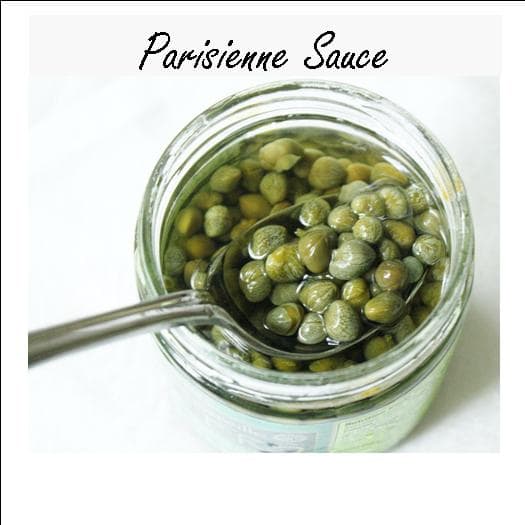Parisienne Sauce was a very popular sauce in the restaurant. It’s a buttery lemony sauce enhanced with the salty tanginess of capers. Capers are the highlight of this sauce. To understand capers one has to know capers. I thought I would share a little story about my childhood and some facts about the tiny delicate caper that’s packed with a huge flavor punch.
These little pungent Mediteranean capers come from the bud of blossoming bushes. I actually had the pleasure of seeing caper bushes. It was many years ago when my brother and I visited our grandparents at their home town on the island of Ischia, Italy. They took us for a leisurely walk through town and we visited the Castello Aragonese, a medieval castle built on volcanic rock. As we walked up to the castle, clinging to the cracked walls and cliffs were these unusual and attractive ornamental shrubs. They were thriving in the sunny hot dry climate of Ischia. The castle is nestled on volcanic rock in the middle of the sea. So these caper shrubs are evidently salt tolerant as well. My Nonno (grandfather) pointed out the capers on the shrubs. The bushy plant had a thick cluster of thorny branches and fleshy, egg shaped leaves. They were as high as five feet in some places, but most were sprawled out over rocks and soil.
Nonno explained that from April to June, the caper shrub’s tiny buds flower into large, sweet-scented, pink blooms clustered with long, violet stamens. The plants harvested for capers, however, rarely blossom. Workers endure hot sun, sharp thorns and rugged terrain throughout the summer to pick the precious buds as they ripen.
I loved this walk up to the castle listening to Nonno explain all of this in his rich napolitano cadence! The long steep climb winding around the castle with the ocean views were breathe taking. Nonno walked ahead explaining all the sites while my Nonna (grandmother) ambled behind slowly carrying her large purse under her arm. My brother and I found our Italian grandparents amusing. At one point we felt a sprinkling of rain as was common in the afternoons in Ischia, a sun shower. Nonno slowed down and turned to ask my Nonna if she was ok. In his tongue in cheek manner, he just shook his head as he watched Nonna dig into her large white purse and pull out a clear plastic rain bonnet for her head and a sweater for her shoulders. My brother and I were hysterically laughing not just at my Nonna but at Nonno’s reaction. What a special caper memory. I think of them whenever I use capers in my cooking.
Let me explain more about capers. Pickling process enhances the flavor of capers. Capers with their tart and briny flavors enrich sauces. Capers are a staple in the Italian kitchen. The tiny, piquant buds are enjoyed from region to region, from the north to the south. In Sicily capers are served in caponata, a summer side dish in which their salty bite cuts through the smooth buttery taste of slow cooked eggplant. In Ischia they are part of spaghetti alla puttanesca. The sauce consists of capers, tomatoes, olives and anchovies. These delicious little gems are often sprinkled over pizza, pasta, and fish dishes as a flavorful garnish.
Most capers come from wild plants, thoughout Spain and Italy—the two largest producers—they are cultivated. Sicily and the Aeolian island of Salina produce the majority of Italy’s capers. The best, though, come from Pantelleria. On this tiny island, halfway to Tunisia, volcanic soil and the heat of an intense Mediterranean sun create ideal growing conditions. The berries are also picked, and both are pickled for use as a seasoning and garnish. The bud, or caper, is pickled in salt and vinegar brine, then sold in vinegar or packed in salt. The berry—the larger, plump, mature fruit of the plant—resembles a green grape with faint, white stripes and, like olives, is served in pastas, salads or even as a garnish in martinis. When choosing capers, look for dark green buds packed tightly in sea salt, because those submerged in vinegar lack the subtle, natural taste of the salted ones. The smaller buds have a more delicate flavor while the larger ones have less taste and could be frauds—sometimes the similar-looking buds of the nasturtium plant are passed off as capers. The French term nonpareil is commonly used to denote the smallest buds; surfines are the next largest. True Italian capers, though, are sorted by millimeter with mechanized screens. They range from 7 millimeters to 16 millimeters. Unfortunately in stores their size is not often marked. Be sure to look for buds not larger than a raisin. If using salted capers, soak them for five to ten minutes and drain to remove excess salt. The large caper berries are eaten “as is” just as you would an olive. You can even serve them in your favorite martini!
See our Parisienne Sauce recipe.

